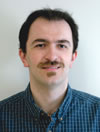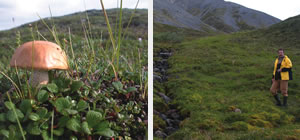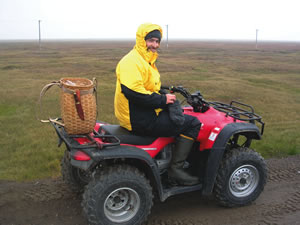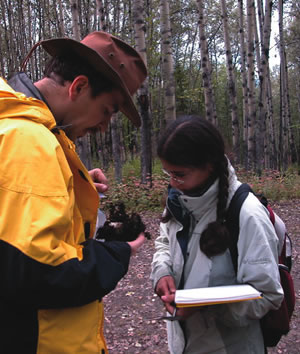UAF IPY postdoctoral fellows
JÓZSEF GEML
by Jenn Wagaman, UAF Center for Research Services

PLANT PATHOLOGY/
MOLECULAR EVOLUTIONARY GENETICS
Pennsylvania State University
POSTDOCTORAL RESEARCH
Compare arctic fungal species to infer relationship patterns between genes and geography to test the hypothesis that most arctic fungal species survived the last glaciation in the Bering Land Bridge
MENTOR
D. Lee Taylor
UAF, Institute of Arctic Biology
HOMETOWN
Sirok, Hungary
IF YOU WEREN'T A SCIENTIST,
WHAT WOULD YOU BE?
"I would be a musician. I've been playing drums and percussions in a lot of rock, jazz and avant-garde bands since I was 13."



The conceptual father of the first International Polar Year was an Austro-Hungarian Navy officer by the name of Karl Weyprecht, who believed polar expeditions should be driven by science rather than by exploration.
It is in this tradition that the quiet Hungarian mycologist József Geml ventured to Alaska to mark a new age in scientific research. His work will provide the international research community with its first glimpse of the circumpolar genetic diversity of mushroom and lichen species in the Arctic.
"I am using DNA sequence data to reconstruct the evolutionary history of fungi," says Geml. "By looking at the biogeography of these species, I am able to gain insights into their past. This will help me highlight biodiversity hotspots around the Arctic that are key not only for nature conservation, but for assessing the resilience of fungal communities to climate change."
Why fungi? "Fungi play a key ecological role in almost any ecosystem, but especially at higher latitudes. For example, there wouldn't be a single tree or brush in Alaska if it weren't for these organisms," he points out. Alaska has perhaps the most diverse landscapes and ecoregions within the northern high latitudes, and the fact that it was largely ice-free during the ice ages is a likely contributor to the present arctic biodiversity. Because no such research has ever been done on fungi, the genetic diversity that Geml is mapping will test this hypothesis and will provide an essential baseline for future circumpolar diversity studies as well.
"It has always fascinated me how much you can learn about the past by simply looking at the distributions of species," says Geml.
Perhaps Geml's love of mushrooms is rooted in his upbringing in Hungary, where he spent many hours with his family in the hills around their home hunting for mushrooms, a tradition he continues in Interior Alaska with his own family today.
"Hungarians and many other Europeans love to go out and hunt for mushrooms," he says. "I think, in a sense, it's like going out fishing in Alaska. The main goal is not only to catch the fish but to spend time outdoors with your children and teach them the love of nature."
Geml's interest in fungi continued into his adulthood when he worked at a mushroom spawn company and breeding lab for four years before going on to obtain two independent doctoral degrees at Pennsylvania State University (in plant pathology and evolutionary genetics) and at the Corvinus University of Budapest (in fungal systematics). His passion has continued.
"I think that the same thing goes for science as for art," says Geml. "A basic understanding and appreciation of science is crucial to having a meaningful life. Not everyone needs to be a scientist of course, but every lay person should learn how to appreciate the natural world we live in because it's a source of endless joy and discovery."
Images courtesy József Geml unless otherwise noted


